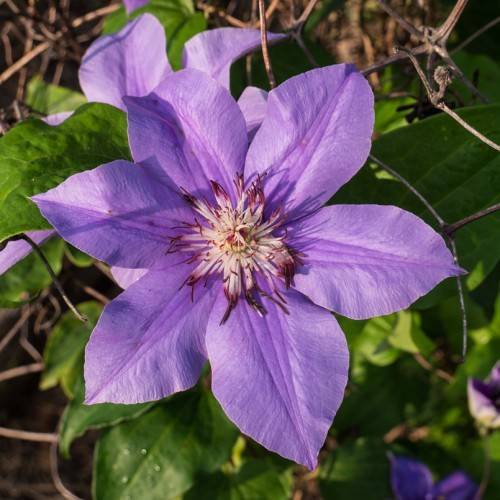
clematis
Clematis 'Ramona'
Cycle:
Perennial
Watering:
Average
Hardiness Zone:
4 - 8
Flowers:
Flowers
Sun:
Full sun,part shade
Leaf:
Yes
Growth Rate:
High
Maintenance:
Low
Salt Tolerant:
Yes
watering
Clematis 'Ramona' is a fast-growing, evergreen vine that should be watered regularly during its growing season. It prefers moist soil, but should not be allowed to become overly soggy or waterlogged. Water deeply, about twice per week, in the spring and summer months. Be sure to thoroughly saturate the soil and then allow it to dry slightly between waterings. In the fall and winter, reduce watering so that the soil becomes nearly dry. If the plant wilts, it may need to be watered more frequently.
sunlight
Clematis 'Ramona' is a climbing vine plant that requires full sun to part shade exposure for optimal growth. It prefers 6-8 hours of direct sunlight per day, though it can tolerate some light shade during the hottest part of the day. During the spring and summer months when the sun is at its highest and strongest, move it to a spot where it can receive dappled or indirect sunlight in order to protect its foliage from the harshness of direct sunlight. In the fall and winter months when the days are shorter, more sun is best for the plant to prevent it from going dormant.
pruning
For best results, prune Clematis ‘Ramona’ in early spring, when growth is just starting to appear on the vine’s shoots. Cut back all of the previous year’s growth by about 1-third to promote new, strong growth as well as to remove any dead or damaged wood. When removing dead or damaged wood, be sure to make the cut just above a healthy bud. Also, if there are any competing vines, remove those to allow the clematis to get as much sunlight as possible. Pruning can also be done in the late summer after all flowering has finished. This is primarily done to tidy up the vine and remove any overgrown vines or to create a specific shape.
FAQ
Can Clematis plants grow in pots?
Yes, Clematis plants can definitely be grown in pots. When planting a Clematis in a pot make sure to use a larger size pot with drainage holes and fill it with a mix of well-draining potting soil and compost. Ensure to keep the root area cool and the pot in a sunny location while providing regular water and fertilization. Check the plant almost daily to make sure it is not becoming too dry. Clematis can do well in a pot and with the right care and conditions, they will thrive.
Are Clematis plants self-pollinating?
No, clematis plants are not self-pollinating. Clematis plants need pollinators such as bees, butterflies, moths and other insects to transfer pollen from the male anthers to the female stigma of the flower in order to produce viable seed. Pollination must also occur within relatively close proximity of the same species in order to create viable hybrid plants.
Can Clematis plants be grown as a houseplant?
Yes, Clematis plants can be grown as a houseplant. It is best to grow them in a pot with full sun and a soil that is rich in organic material and retains moisture. When potting the plant, place a stake or trellis next to the pot so that the vine can climb when it begins to grow. Be sure to water your Clematis plant regularly to keep it healthy and growing. Additionally, keep an eye out for pests and treat with natural insecticides as necessary.
Could Clematis plants survive in a colder climate?
Yes, Clematis plants can survive in colder climates with proper preparation. If planted in the fall, proper mulching should be done to protect the roots from cold temperatures. If planted in the spring, they should be watered frequently to help them adjust to the cooler temperatures more quickly. If temperatures drop below -20°C ( -4°F), additional measures may need to be taken such as the application of protective wraps and thermal insulation. Additionally, plants in exposed areas should be protected from the wind to prevent excessive dehydration. With the right measures in place, Clematis plants can easily survive in colder climates.
Could Clematis plants be grown in a greenhouse?
Yes, clematis plants can be grown in a greenhouse. Due to their vine-like growth habit and tropical native origins, clematis plants thrive in the moist and warm environment of a greenhouse. Clematis are generally grown from cuttings or from dividing existing plants, and benefit from regular pruning and fertilizing. They will also enjoy the indirect light of a greenhouse and the protection from strong winds and temperatures that the humidity and contained environment provides.
